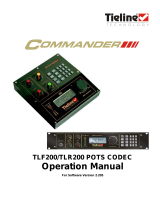
Samsung System Administration Guide
DCS-408 & 408i November 2001
1
A
bout This Guide
This guide describes the most commonly-used special features available with the
Samsung DCS 408 and 408i keyphone systems which the system administrator can
use to ensure the system is working correctly, effectively and to best suit your working
environment. You have access to all these features through a Samsung digital display
(LCD) keyset operating under special passcode control for security.
Station users can be trained to use only the features that they require, to help control
costs and telephone abuse. Comprehensive information for station users will be found
in the relevant user guide for their telephone (see Related Manuals, below).
Several of the features listed in this guide are specific to the system operator (some-
times called the attendant position). You can have more than one operator or set up
your system to be used without an operator.
Using your customer-level passcode, you can access specific programs (MMCs)—
designated by your system installer—to set, view or modify certain functions to better
manage your keyphone system. Instructions are detailed and easy to follow. However,
if assistance is needed, don’t hesitate to contact your Samsung dealer or system in-
staller for advice.
How This Guide is Organised
The guide is organised in three sections.
•
Special Features—
Discusses the most frequently used administration features
such as setting account and authorisation codes, monitoring conversations taking
place at other stations, and so on.
•
CLIP Special Features (408i systems only)—Describes how to make the best use
of caller identification options, especially for monitoring calls to and from other sta-
tions
•
System Administrator Programming—
Shows you how to program selected spe-
cial features using MMC programming.
Related Manuals
You should also refer to the following documentation which provides more detailed in-
formation on 408/408i system and keyset programming and features.
•
Samsung DCS Combined Programming Manual
This comprehensively covers all programming (MMC) procedures for all DCS
keyphone systems, including the DCS 408 and 408i. Refer to this for details of
MMCs not covered in the “System Administrator Programming”
section of this
guide.
•
Samsung DCS Keyset User Guide
This describes the use of Samsung digital display keysets. If your system in-
cludes other types of telephones (single line telephones, for example), refer to
the User Guides or Quick Reference Guides supplied specifically for those tele-
phones.






















